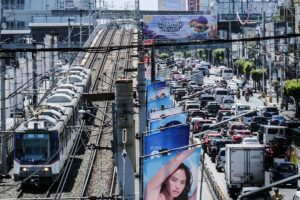THE Philippine government should consider establishing a rail regulatory agency to protect commuters from price gouging and ensure that rail transportation infrastructure projects are on-track, according to a congressional think-tank.
Reducing traffic congestion in Metro Manila requires the government to advocate for the use of railway systems further by making train fares cheap, the Congressional Policy and Budget Research Department (CPBRD) said in a February report.
“Leaving the rail sector fully into the hands of the private sector could result in negative externalities and market failures. Lack of market regulation, especially in ensuring competition and addressing anti-competitive practices, will allow private operators to maximize their profits in rail operations without regard to public welfare,” CPBRD author Ricardo P. Mira said in the 27-page discussion paper.
“The government should take the lead in promoting a culture of rail commuting among Filipinos by ensuring fast, safe, reliable, and reasonably-priced rail transport services,” he added.
The Philippines is hard-pressed to decongest heavy traffic in Metro Manila, which the TomTom Traffic Index found to be the 14th most congested city in the world in 2024. Commuters in the city take around 32 minutes to travel 10 kilometers (km) on average, the report noted.
The Southeast Asian nation also has the shortest railway system among its regional neighbors, with only 228 km of total track length, according to 2023 data from the Association of Southeast Asian Nations. It follows Singapore (259 km), Laos (423.5 km), Cambodia (652 km), Malaysia (1,799.4 km), Vietnam (2,646.1 km), Thailand (5,098.2 km), and Indonesia (5,483 km).
Railway operators should also reduce service interruptions caused by technical and operational issues to further boost the use of public trains, the think-tank said. “Successful urban rail development is usually associated with careful planning of network and modal integration.”
Policymakers should also look at regulating private car ownership in Metro Manila to maximize investments in railway upgrades, it added.
“This policy should not only mitigate traffic congestion but also promote rail patronage among vehicle owners.”
Moreover, lawmakers could prioritize proposed amendments to the 2016 Right-of-Way (ROW) Act to help advance railway construction projects amid ROW issues, the think-tank said.
At present, the government is required to relocate residents affected by railway projects and provide compensation for underground boring and construction activities.
November 2024 data from the Department of Transportation (DoTr) showed that only 1,756 out of 50,633 informal settlers have been relocated.
Further, the report noted that the ROW law provided property owners rights to their land up to 50 meters below ground level. This means the government can enter into and use subsurface or subterranean portions more than 50 meters from the surface.
“An important amendment relevant to the rail sector is the proposed reduction of the subterranean ROW from 50 meters to 15 meters from the surface, which could allow the DoTr and other government agencies to build more subterranean infrastructure in the future,” it said.
“This makes economic sense because it will help relieve the government from compensating costly subterranean ROW in future subway projects,” it added.
The House of Representatives approved on third reading its version of the measure in February 2023, with its counterpart proposal in the Senate pending plenary deliberations. — Kenneth Christiane L. Basilio
